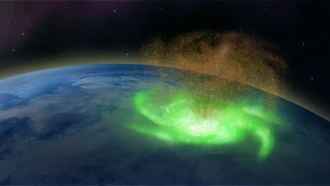
Carolyn Gramling
Earth & Climate Writer
Carolyn is the Earth & Climate writer at Science News. Previously she worked at Science magazine for six years, both as a reporter covering paleontology and polar science and as the editor of the news in brief section. Before that she was a reporter and editor at EARTH magazine. She has bachelor’s degrees in Geology and European History and a Ph.D. in marine geochemistry from MIT and the Woods Hole Oceanographic Institution. She’s also a former Science News intern.

Trustworthy journalism comes at a price.
Scientists and journalists share a core belief in questioning, observing and verifying to reach the truth. Science News reports on crucial research and discovery across science disciplines. We need your financial support to make it happen – every contribution makes a difference.
All Stories by Carolyn Gramling
-
 Climate
ClimateRecord-breaking Coral Sea temperatures threaten the Great Barrier Reef
Near-annual extreme heat in the Coral Sea, including in 2024, is causing back-to-back mass bleaching events in the iconic Great Barrier Reef.
-
 Climate
ClimateEarth’s jet stream helps create the seeds of clouds
The newly discovered process for making aerosols might also be the most productive.
-
 Climate
ClimateEarth keeps breaking global heat records
How hot could it get? In the first edition of Science News’ Extreme Climate Update, we look at how high temperatures could soar.
-
 Climate
ClimatePlants might not hold on to carbon as long as we thought
Radiocarbon from bomb tests reveals that plants store more carbon than previously estimated in leaves and stems, which are vulnerable to degradation.
-

‘Space hurricanes’ churn at both of Earth’s magnetic poles
The southern hemisphere’s ionosphere experiences about 23 space hurricanes per year, which is on par with the northern hemisphere.
-
 Climate
ClimateWhy this year’s climate conditions helped Hurricane Beryl smash records
Scientists predicted an active hurricane season, but a July Category 5 storm is still stunning.
-
 Paleontology
PaleontologyMeet Lokiceratops, a newly discovered species of horned dinosaur
Found in Montana’s badlands, Lokiceratops had two large, bladelike horns jutting forward and out from between its eyes.
-
 Climate
ClimateThe Arctic is warming rapidly. These clouds may hold clues as to why
Climate simulations can’t fully handle towering Arctic thunderclouds. So scientists have been flying a C-130 into and around the clouds to learn more.
-
 Paleontology
Paleontology‘Echidnapus’ hints at a lost age of egg-laying mammals
The fossil discoveries double the number of known monotreme species during the Cretaceous Period.
-
 Earth
EarthIn 2018, Hawaii’s Kilauea volcano erupted like a stomp rocket
The stomp rocket–like mechanism is a newly observed type of eruption.
-
 Earth
EarthFreshwater first appeared on Earth 4 billion years ago, ancient crystals hint
Oxygen ratios in ancient zircon crystals suggest that the planet’s water cycle got started hundreds of millions of years earlier than thought.
-
 Environment
Environment‘The High Seas’ tells of the many ways humans are laying claim to the ocean
The book explains how the race for ocean resources from fish to ores to new medicines — the Blue Acceleration — is playing out.